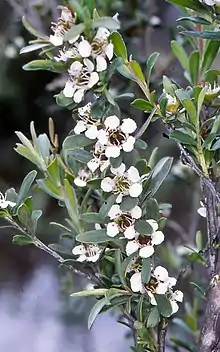Leptospermum obovatum
Leptospermum obovatum, commonly known as river teatree,[2] is a species of shrub that is endemic to south-eastern continental Australia. It has egg-shaped or lance-shaped leaves that are narrower at the base, white flowers usually arranged singly on short side shoots and fruit that remains on the plant until it dies.
| River teatree | |
|---|---|
 | |
| Leptospermum obovatum in Namadgi National Park | |
| Scientific classification | |
| Kingdom: | Plantae |
| Clade: | Tracheophytes |
| Clade: | Angiosperms |
| Clade: | Eudicots |
| Clade: | Rosids |
| Order: | Myrtales |
| Family: | Myrtaceae |
| Genus: | Leptospermum |
| Species: | L. obovatum |
| Binomial name | |
| Leptospermum obovatum | |
| Synonyms[1] | |

Description
Leptospermum obovatum is a densely foliaged shrub that typically grows to a height of about 2 m (6 ft 7 in) with thin, firm bark on the older stems. It has aromatic, egg-shaped or lance-shaped leaves that are narrower at the base, 5–20 mm (0.20–0.79 in) long and 2–8 mm (0.079–0.315 in) or more wide on a very short petiole. The flowers are borne singly, sometimes in pairs on short side shoots. The flowers are white, 8–12 mm (0.31–0.47 in) wide with reddish brown bracts at the base of the flower bud but that fall before the flowers open. The floral cup is glabrous, 2.5–3.5 mm (0.098–0.138 in) long on a short pedicel. The sepals are triangular to broadly egg-shaped or almost round, 2–2.5 mm (0.079–0.098 in) long, the petals 3–4 mm (0.12–0.16 in) long and the stamens 2–2.5 mm (0.079–0.098 in) long. Flowering mainly occurs from November to January and the fruit is a broadly hemispherical capsule 5–8 mm (0.20–0.31 in) in diameter and that remains on the plant until it dies, the sepal remnants having fallen.[2][3][4]
Taxonomy and naming
Leptospermum obovatum was first formally described by in 1827 Robert Sweet in his book Flora Australasica.[5] The specific epithet (obovatum) is a Latin word meaning "obovate".[6]
Distribution and habitat
River teatree grows among rocks, near swift-flowing streams and often in swampy places. It is found on the Southern Tablelands and South Coast of New South Wales and is widespread in southern Victoria.[2][3][4]
Use in horticulture
This species can be grown from seed or from cuttings and is hardy in cultivation. It will grow in heavy shade, is frost hardy, and a useful screening plant.[7]
References
- "Leptospermum obovatum". Australian Plant Census. Retrieved 10 May 2020.
- Lyne, Andrew. "Leptospermum obovatum". Royal Botanic Gardens, Victoria. Retrieved 10 May 2020.
- Thompson, Joy (1989). "A revision of the genus Leptospermum (Myrtaceae)". Telopea. 3 (3): 412–413.
- "Leptospermum obovatum". Royal Botanic Garden, Sydney. Retrieved 9 May 2020.
- "Leptospermum obovatum". APNI. Retrieved 10 May 2020.
- William T. Stearn (1992). Botanical Latin. History, grammar, syntax, terminology and vocabulary (4th ed.). Portland, Oregon: Timber Press. p. 454.
- "Leptospermum obovatum". Information about Australia's Flora. Australian National Botanic Gardens, Canberra. Retrieved 7 March 2015.